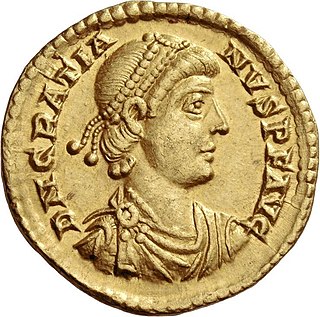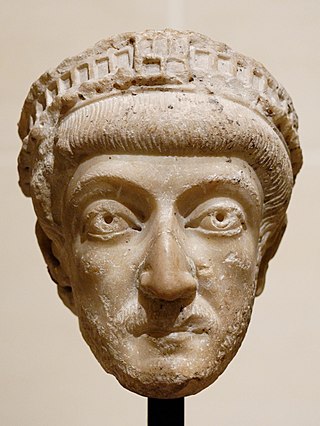Related Research Articles
The 380s decade ran from January 1, 380, to December 31, 389.
The 430s decade ran from January 1, 430, to December 31, 439.
The 420s decade ran from January 1, 420, to December 31, 429.

Year 590 (DXC) was a common year starting on Sunday of the Julian calendar. The denomination 590 for this year has been used since the early medieval period, when the Anno Domini calendar era became the prevalent method in Europe for naming years.

Year 421 (CDXXI) was a common year starting on Saturday of the Julian calendar. At the time, it was known as the Year of the Consulship of Agricola and Eustathius. The denomination 421 for this year has been used since the early medieval period, when the Anno Domini calendar era became the prevalent method in Europe for naming years.
Year 388 (CCCLXXXVIII) was a leap year starting on Saturday of the Julian calendar. At the time, it was known as the Year of the Consulship of Augustus without colleague. The denomination 388 for this year has been used since the early medieval period, when the Anno Domini calendar era became the prevalent method in Europe for naming years.

Year 383 (CCCLXXXIII) was a common year starting on Sunday of the Julian calendar. At the time, it was known as the Year of the Consulship of Merobaudes and Saturninus. The denomination 383 for this year has been used since the early medieval period, when the Anno Domini calendar era became the prevalent method in Europe for naming years.

Year 293 (CCXCIII) was a common year starting on Sunday of the Julian calendar. In the Roman Empire, it was known as the Year of the Consulship of Diocletian and Maximian. The denomination 293 for this year has been used since the early medieval period, when the Anno Domini calendar era became the prevalent method in Europe for naming years.
Year 283 (CCLXXXIII) was a common year starting on Monday of the Julian calendar. At the time, it was known as the Year of the Consulship of Carus and Carinus. The denomination 283 for this year has been used since the early medieval period, when the Anno Domini calendar era became the prevalent method in Europe for naming years.

Year 441 (CDXLI) was a common year starting on Wednesday of the Julian calendar. At the time, it was known as the Year of the Consulship of Seleucus without colleague. The denomination 441 for this year has been used since the early medieval period, when the Anno Domini calendar era became the prevalent method in Europe for naming years.

Theodosius II was Roman emperor from 408 to 450. He was proclaimed Augustus as an infant and ruled as the Eastern Empire's sole emperor after the death of his father, Arcadius, in 408. His reign was marked by the promulgation of the Theodosian law code and the construction of the Theodosian Walls of Constantinople. He also presided over the outbreak of two great Christological controversies, Nestorianism and Eutychianism.

Khosrow II, commonly known as Khosrow Parviz, is considered to be the last great Sasanian King of Kings (Shahanshah) of Iran, ruling from 590 to 628, with an interruption of one year.

Yazdegerd I was the Sasanian King of Kings of Iran from 399 to 420. A son of Shapur III, he succeeded his brother Bahram IV after the latter's assassination.

Bahram V, also known as Bahram Gur, was the Sasanian King of Kings (shahanshah) from 420 to 438.
Acacius of Amida was bishop of Amida, Mesopotamia from 400 to 425, during the reign of the Eastern Roman Emperor Theodosius II. He has no extant writings, but his life is documented by Socrates Scholasticus, in the 21st chapter of the 7th book of his Church History. There, he is described as freeing thousands of slaves.

The Sasanian Empire, officially Ērānšahr, was the last empire of ancient Iran. Named after the House of Sasan, it endured for over four centuries, from 224 to 651, making it the second longest-lived imperial Iranian dynasty after the directly preceding Arsacid dynasty of Parthia.

The Roman–Sasanian war of 421–422 was a conflict between the Eastern Roman Empire and the Sasanians. The casus belli was the persecution of Christians by the Sassanid king Bahram V, which had come as a response to attacks by Christians against Zoroastrian temples; the Christian Eastern Roman Emperor Theodosius II declared war and obtained some victories, but in the end, the two powers agreed to sign a peace on the status quo ante.

Year 420 (CDXX) was a leap year starting on Thursday of the Julian calendar. At the time, it was known as the Year of the Consulship of Theodosius and Constantius. The denomination 420 for this year has been used since the early medieval period, when the Anno Domini calendar era became the prevalent method in Europe for naming years.

The Sassanid Empire or Sassanian Dynasty is the name used for the Persian dynasty which lasted from 224 to 651 AD.
The history of the Later Roman Empire covers the history of the Roman Empire from the beginning of the rule of Diocletian in 284 AD and the establishment of the Tetrarchy in 293 AD by Diocletian to the death of Heraclius in 641 AD.
References
- ↑ Daryaee, Touraj (2023). Sasanian Persia: The Rise and Fall of an Empire. London: I. B. Tauris & Company. p. 31. ISBN 978-0-75561-842-2.